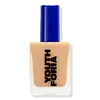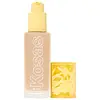What's inside
What's inside
 Key Ingredients
Key Ingredients

 Benefits
Benefits

 Concerns
Concerns

No concerns
 Ingredients Side-by-side
Ingredients Side-by-side

Water
Skin ConditioningTitanium Dioxide
Cosmetic ColorantCetyl Ethylhexanoate
EmollientButylene Glycol Dicaprylate/Dicaprate
EmollientDicaprylyl Carbonate
EmollientIsododecane
EmollientHydrogenated Polydecene
EmollientPolyglyceryl-2 Oleate
EmulsifyingGlycerin
HumectantPolyhydroxystearic Acid
EmulsifyingMethyl Methacrylate Crosspolymer
Magnesium Stearate
Cosmetic ColorantMagnesium Sulfate
Centella Asiatica Extract
CleansingPolyglyceryl-2 Stearate
EmulsifyingDipropylene Glycol
HumectantDisteardimonium Hectorite
StabilisingSodium Hyaluronate
HumectantSodium Acetylated Hyaluronate
HumectantHydrolyzed Hyaluronic Acid
HumectantHydroxypropyltrimonium Hyaluronate
Sodium Hyaluronate Crosspolymer
HumectantHydroxyacetophenone
AntioxidantTocopheryl Acetate
AntioxidantPropylene Carbonate
SolventCaprylyl Glycol
EmollientButylene Glycol
HumectantDiospyros Kaki Leaf Extract
Skin ProtectingVitis Vinifera Fruit Extract
Skin ConditioningAllantoin
Skin ConditioningCeramide AP
Skin Conditioning1,2-Hexanediol
Skin ConditioningCoffea Arabica Seed Extract
MaskingCarthamus Tinctorius Flower Extract
Skin ConditioningPolygonum Cuspidatum Root Extract
AntioxidantCamellia Sinensis Leaf Extract
AntimicrobialCastanea Crenata Shell Extract
Skin ConditioningZanthoxylum Piperitum Fruit Extract
Skin ConditioningMaltodextrin
AbsorbentMethylpropanediol
SolventDipotassium Glycyrrhizate
HumectantPanthenol
Skin ConditioningPentylene Glycol
Skin ConditioningAdenosine
Skin ConditioningCapparis Spinosa Fruit Extract
Skin ConditioningDisodium Stearoyl Glutamate
CleansingOlea Europaea Leaf Extract
PerfumingOpuntia Ficus-Indica Stem Extract
Skin ConditioningHydroxyphenyl Propamidobenzoic Acid
Skin ConditioningEthylhexylglycerin
Skin ConditioningAscorbyl Palmitate
AntioxidantCI 77007
Cosmetic ColorantCI 77492
Cosmetic ColorantCI 77491
Cosmetic ColorantCI 77499
Cosmetic ColorantWater, Titanium Dioxide, Cetyl Ethylhexanoate, Butylene Glycol Dicaprylate/Dicaprate, Dicaprylyl Carbonate, Isododecane, Hydrogenated Polydecene, Polyglyceryl-2 Oleate, Glycerin, Polyhydroxystearic Acid, Methyl Methacrylate Crosspolymer, Magnesium Stearate, Magnesium Sulfate, Centella Asiatica Extract, Polyglyceryl-2 Stearate, Dipropylene Glycol, Disteardimonium Hectorite, Sodium Hyaluronate, Sodium Acetylated Hyaluronate, Hydrolyzed Hyaluronic Acid, Hydroxypropyltrimonium Hyaluronate, Sodium Hyaluronate Crosspolymer, Hydroxyacetophenone, Tocopheryl Acetate, Propylene Carbonate, Caprylyl Glycol, Butylene Glycol, Diospyros Kaki Leaf Extract, Vitis Vinifera Fruit Extract, Allantoin, Ceramide AP, 1,2-Hexanediol, Coffea Arabica Seed Extract, Carthamus Tinctorius Flower Extract, Polygonum Cuspidatum Root Extract, Camellia Sinensis Leaf Extract, Castanea Crenata Shell Extract, Zanthoxylum Piperitum Fruit Extract, Maltodextrin, Methylpropanediol, Dipotassium Glycyrrhizate, Panthenol, Pentylene Glycol, Adenosine, Capparis Spinosa Fruit Extract, Disodium Stearoyl Glutamate, Olea Europaea Leaf Extract, Opuntia Ficus-Indica Stem Extract, Hydroxyphenyl Propamidobenzoic Acid, Ethylhexylglycerin, Ascorbyl Palmitate, CI 77007, CI 77492, CI 77491, CI 77499
Zinc Oxide 7.5%
Cosmetic ColorantWater
Skin ConditioningEthylhexyl Olivate
Skin ConditioningOctyldodecanol
EmollientUndecane
EmollientPolyglyceryl-2 Dipolyhydroxystearate
Skin ConditioningGlycerin
HumectantMica
Cosmetic ColorantCalcium Sodium Borosilicate
Caprylic/Capric Triglyceride
MaskingNiacinamide
SmoothingPolyglyceryl-3 Diisostearate
EmulsifyingGalactoarabinan
Tridecane
PerfumingPropanediol
SolventCetyl Alcohol
EmollientGlyceryl Oleate
EmollientSodium Hyaluronate
HumectantPalmitoyl Tripeptide-5
Skin ConditioningPanthenol
Skin ConditioningSqualane
EmollientCaffeine
Skin ConditioningArnica Montana Flower Extract
MaskingArtemisia Capillaris Flower Extract
Skin ConditioningEthyl Ferulate
AntioxidantSodium Gluconate
Skin ConditioningPolyhydroxystearic Acid
EmulsifyingMaltodextrin
AbsorbentPentylene Glycol
Skin ConditioningLecithin
EmollientHydrogenated Lecithin
EmulsifyingTocopherol
AntioxidantPhenethyl Alcohol
MaskingCI 77891
Cosmetic ColorantIron Oxides
Zinc Oxide 7.5%, Water, Ethylhexyl Olivate, Octyldodecanol, Undecane, Polyglyceryl-2 Dipolyhydroxystearate, Glycerin, Mica, Calcium Sodium Borosilicate, Caprylic/Capric Triglyceride, Niacinamide, Polyglyceryl-3 Diisostearate, Galactoarabinan, Tridecane, Propanediol, Cetyl Alcohol, Glyceryl Oleate, Sodium Hyaluronate, Palmitoyl Tripeptide-5, Panthenol, Squalane, Caffeine, Arnica Montana Flower Extract, Artemisia Capillaris Flower Extract, Ethyl Ferulate, Sodium Gluconate, Polyhydroxystearic Acid, Maltodextrin, Pentylene Glycol, Lecithin, Hydrogenated Lecithin, Tocopherol, Phenethyl Alcohol, CI 77891, Iron Oxides
Ingredients Explained
These ingredients are found in both products.
Ingredients higher up in an ingredient list are typically present in a larger amount.
Glycerin is already naturally found in your skin. It helps moisturize and protect your skin.
A study from 2016 found glycerin to be more effective as a humectant than AHAs and hyaluronic acid.
As a humectant, it helps the skin stay hydrated by pulling moisture to your skin. The low molecular weight of glycerin allows it to pull moisture into the deeper layers of your skin.
Hydrated skin improves your skin barrier; Your skin barrier helps protect against irritants and bacteria.
Glycerin has also been found to have antimicrobial and antiviral properties. Due to these properties, glycerin is often used in wound and burn treatments.
In cosmetics, glycerin is usually derived from plants such as soybean or palm. However, it can also be sourced from animals, such as tallow or animal fat.
This ingredient is organic, colorless, odorless, and non-toxic.
Glycerin is the name for this ingredient in American English. British English uses Glycerol/Glycerine.
Learn more about GlycerinMaltodextrin is a polysaccharide. It is derived from starch such as rice, corn, wheat, or potato starch.
In food, Maltodextrin is used to improve the texture and thicken a product. Due to its structure, it can help create a gel texture. As an emulsion stabilizer, it helps keep the ingredients in a product together.
As a polysaccharide, Maltodextrin has moisturizing properties. Polysaccharides are a type of carbohydrate. The top layer of skin uses polysaccharides to retain water, keeping the skin hydrated.
Maltodextrin is water soluble and has a sweet taste.
Learn more about MaltodextrinPanthenol is a common ingredient that helps hydrate and soothe the skin. It is found naturally in our skin and hair.
There are two forms of panthenol: D and L.
D-panthenol is also known as dexpanthenol. Most cosmetics use dexpanthenol or a mixture of D and L-panthenol.
Panthenol is famous due to its ability to go deeper into the skin's layers. Using this ingredient has numerous pros (and no cons):
Like hyaluronic acid, panthenol is a humectant. Humectants are able to bind and hold large amounts of water to keep skin hydrated.
This ingredient works well for wound healing. It works by increasing tissue in the wound and helps close open wounds.
Once oxidized, panthenol converts to pantothenic acid. Panthothenic acid is found in all living cells.
This ingredient is also referred to as pro-vitamin B5.
Learn more about PanthenolPentylene glycol is typically used within a product to thicken it. It also adds a smooth, soft, and moisturizing feel to the product. It is naturally found in plants such as sugar beets.
The hydrophilic trait of Pentylene Glycol makes it a humectant. As a humectant, Pentylene Glycol helps draw moisture from the air to your skin. This can help keep your skin hydrated.
This property also makes Pentylene Glycol a great texture enhancer. It can also help thicken or stabilize a product.
Pentylene Glycol also acts as a mild preservative and helps to keep a product microbe-free.
Some people may experience mild eye and skin irritation from Pentylene Glycol. We always recommend speaking with a professional about using this ingredient in your routine.
Pentylene Glycol has a low molecular weight and is part of the 1,2-glycol family.
Learn more about Pentylene GlycolPolyhydroxystearic Acid is a soft wax made from castor oil.
It is is a texture thickener, emulsifier, and film-former. Emulsifiers prevent ingredients from separating, such as oils and waters.
Polyhydroxystearic Acid may not be fungal acne safe.
Learn more about Polyhydroxystearic AcidSodium Hyaluronate is hyaluronic acid's salt form. It is commonly derived from the sodium salt of hyaluronic acid.
Like hyaluronic acid, it is great at holding water and acts as a humectant. This makes it a great skin hydrating ingredient.
Sodium Hyaluronate is naturally occurring in our bodies and is mostly found in eye fluid and joints.
These are some other common types of Hyaluronic Acid:
Learn more about Sodium HyaluronateWater. It's the most common cosmetic ingredient of all. You'll usually see it at the top of ingredient lists, meaning that it makes up the largest part of the product.
So why is it so popular? Water most often acts as a solvent - this means that it helps dissolve other ingredients into the formulation.
You'll also recognize water as that liquid we all need to stay alive. If you see this, drink a glass of water. Stay hydrated!
Learn more about Water